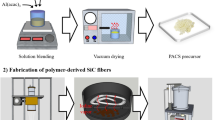Abstract
Using polymer-derived technology, continuous high-temperature resistant Si-Al-C fibers were prepared by one step method, which included melt-spinning of polyaluminocarbosilane (PACS), curing of continuous PACS fibers, and sintering of the cured products. The results show that the average diameter and tensile strength of continuous Si-Al-C fibers are 11 to 12 μm and 1.8 to 2.0 GPa, respectively. The chemical formula of Si-Al-C fibers is SiC1.01O0.0400Al0.024, which is nearly stoichometric. The fibers are mainly composed of β-SiC crystalline, small amount of α-SiC, and amorphous SiC. Continuous Si-Al-C fibers exhibit excellent thermal stability. When the fibers were exposed in argon for 1 h, the tensile strength did not decrease until 1500°C. After heat treatment at 1800°C in argon for 1 h, the fibers maintained about 80% of the initial strength. It was higher than that of Nicalon and Hi-Nicalon fibers.
Similar content being viewed by others
References
Johnson D W, Evans A G, Goettler R W. Ceramic Fibers and Coatings: Advanced Materials for the Twenty-First Century. Publication NMAB-494, Washington D C: National Academy Press, 1998. 1–49
Yajima S, Hayashi J, Omori M, et al. Development of a SiC fiber with high tensile strength. Nature, 1976, 262: 683–685
Laine R M, Babonneau F. Preceramic polymer routes to silicon carbide. Chem Mater, 1993, 5: 260–279
Sacks M D. Effect of composition and heat treatment conditions on the tensile strength and creep resistance of SiC-based fibers. J Europ Ceram Soc, 1999, 19(10): 2305–2315
Toreki W, Batich C D, Sacks M D, et al. Polymer-derived silicon carbide fibers with low oxygen content and improved thermomechanical stability. Comp Sci Technol, 1994, 51(2): 145–159
Kakimoto K I, Shimoo T, Okamura K. Oxidation-induced microstructural change of Si-Ti-C-O fibers. J Am Ceram Soc, 1998, 81(2): 409–412
Kumagawa K, Yamaoka H, Shibuya M, et al. Thermal stability and chemical corrosion resistance of newly developed continuous Si-Zr-C-O Tyranno fiber. Ceram Eng Sci Proc, 1997, 18(3): 113–118
Lipowitz J, Barnard T, Bujalski D, et al. Fine-diameter polycrystalline SiC fibers. Comp Sci Technol, 1994, 51(2): 167–171
Ishikawa T, Kohtoku Y, Kumagawa K, et al. High-strength alkali-resistant sintered SiC fiber stable able to 2200°C. Nature, 1998, 391: 773–774
Cao F, Li X D, Peng P, et al. Structural evolution and associated properties on conversion from Si-C-O-Al ceramic fibers to Si-C-Al fibers by sintering. J Mater Chem, 2002, 12(3): 606–610
Zheng C M, Li X D, Yu Y X, et al. Preparation of high temperature resistance Si-Al-C-O fibers by polymer-derived method (in Chinese). J Mater Eng, 2004, 259(12): 25–28
Wang Y D, Feng C X, Song Y C. Study on process of continuous SiC fibers (in Chinese). Aerospace Mater Technol, 1997, 27(2): 21–25
Vahlas C. Thermodynamic approach to the oxidation of Hi-Nicalon™ fiber. J Am Ceram Soc, 1999, 82(9): 2514–2516
Suzuki K, Kumagawa K, Kamiyama T, et al. Characterization of the medium-range structure of Si-Al-C-O, Si-Zr-C-O, and Si-Al-C Tyranno fibers by small angle X-ray scattering. J Mater Sci, 2002, 37(5): 949–953
Du T F. Modern Instrument and Analysis (in Chinese). Changsha: National University of Defense Technology Press, 1994. 250–273
Hartman J S, Richardson M F, Sherriff B L, et al. Magic angle spinning NMR studies of silicon carbide polytypes, impurities, and highly inefficient spin-lattice relaxation. J Am Chem Soc, 1987, 109(20): 6059–6067
Wagner G W, Na B K, Vannice M A. High-resolution solid-state NMR of 29Si and 13C in β-Silicon carbides. J Phy Chem, 1989, 93(13): 5061–5064
Yang N R, Yue W H. The Handbook of Inorganic Metalloid Materials Atlas (in Chinese). Wuhan: Wuhan Industry University Press, 2000. 608–609
Babonneau F, Soraru G D, Thorne K J, et al. Chemical characterization of Si-Al-C-O precursor and its pyrolysis. J Am Ceram Soc, 1991, 74(7): 1725–1728
Li X D, Edirisinghe M J. Evolution of the ceramic structure during thermal degradation of a Si-Al-C-O precursor. Chem Mater, 2004, 16(6): 1111–1119
Author information
Authors and Affiliations
Corresponding authors
Additional information
Supported by the National Natural Science Foundation of China (Grant No. 59972042)
Rights and permissions
About this article
Cite this article
Zheng, C., Li, X., Wang, H. et al. Preparation and characterization of continuous high-temperature resistant Si-Al-C fibers by one-step method. Sci. China Ser. E-Technol. Sci. 51, 1425–1432 (2008). https://doi.org/10.1007/s11431-008-0106-9
Received:
Accepted:
Published:
Issue Date:
DOI: https://doi.org/10.1007/s11431-008-0106-9




